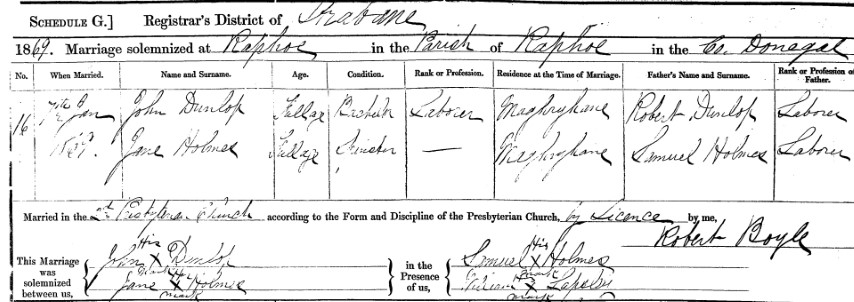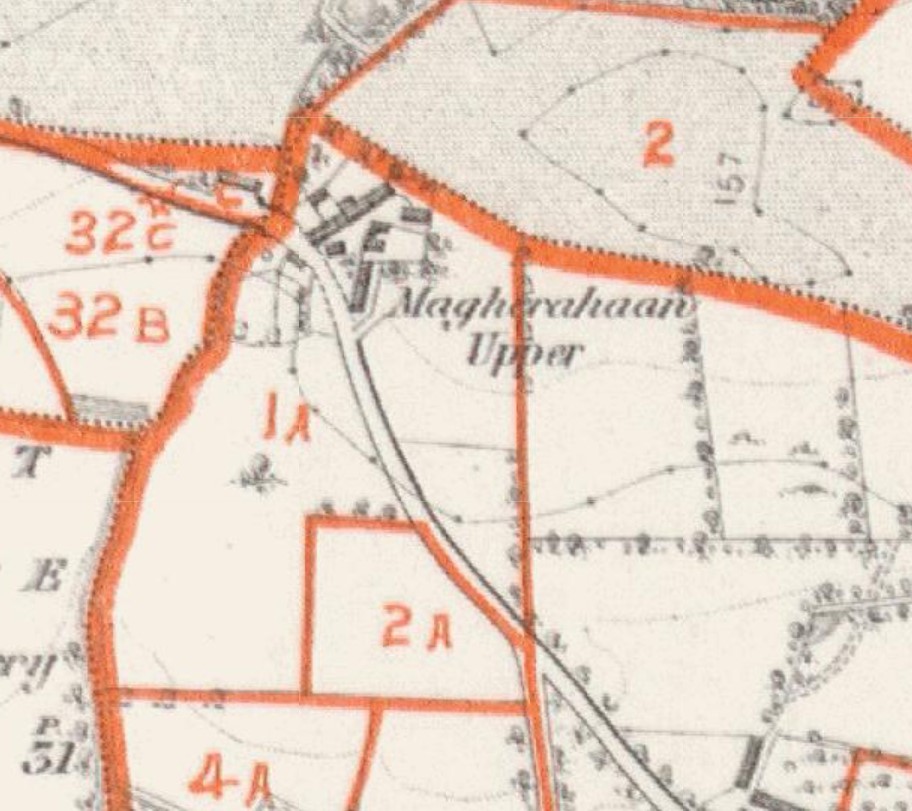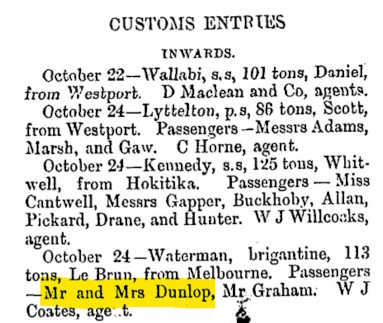The Emigration of John Dunlop
I was down at the Oxford Museum this morning. Chatting to one of the custodians, Mr. Dunlop, he mentioned a family mystery regarding his grandmother, Jane (Gillespie) Dunlop. We will write more about her in a future post; this one is about her husband and in-laws.
John Dunlop & Jane Holmes’s marriage
Jane Gillespie’s husband Robert Dunlop was born 6 January 1870 in the townland of Magherahaan, which is just outside the village of Raphoe, County Donegal, Ireland.
Looking up the named parents in the Irish Civil Registration search, we also find the marriage of his parents, 12 months earlier:
The top line of this record says Registrar’s District of Strabane. Strabane is in County Tyrone; however the Superintendant Registrar’s Districts often spanned county boundaries. The village of Raphoe is in County Donegal, but it’s nearer to the Strabane Workhouse than to any of the County Donegal workhouses. The workhouses doubled as registration centres.
This did cause a problem in 1922 when Ireland was partitioned into the Irish Free State and Northern Ireland; records held at workhouses in the North for people born in the Free State had to be reassigned to other registration centres, so your ancestors from those border regions may have records in different registration districts, despite never physically moving!
Magherahaan and spelling variants
The location of the event is written in the left-hand box on the two records above. It’s spelt Magheraghan on Robert’s birth, and Magheraghane on John & Jane’s marriage. The government spelling of the townland is Magherahaan. This kind of variation was the norm for Irish placenames; the names were of course from the Irish language but anglicised by the government when taking records. The letter g would have been silent in this placename.
The eagle-eyed readers would have spotted a similar situation on Robert’s birth registration above – his surname is spelt as Delap. Checking John Grenham’s surname map, this spelling did occur mainly in the north of Ireland, and particularly around the parts of County Donegal we are looking at. Does this indicate the original pronunciation used by the family, perhaps, before anglicising to Dunlop ?
Anyway… looking in the Griffith’s Valuation search, a survey of Ireland from the 1850s, we see that Samuel Holmes and Robert “Dunlap” – the parents of John and Jane – leased houses in Lot 1A. Checking the Map link from this search result, Lot 1A corresponds to the small settlement of Magherahaan Upper.
So, a likely story would have been that John and Jane grew up as neighbour kids in this hamlet and fell in love. The fact that their first child was born more than 9 months after the wedding indicates that it was likely to be a genuine partnership, as opposed to a “shotgun wedding”.
Emigration to the West Coast
Nevertheless, the couple decided to emigrate to New Zealand; after their first child Robert’s birth in January 1870, the next civil record that we see for the couple is the New Zealand birth of their son John, on 28 January 1873 on the West Coast of the South Island.
So: how, when and why did they come here? A search of FamilySearch - New Zealand Passenger Lists proves fruitless.
Fortunately, a clue turns up from a careful search of PapersPast. Narrowing the search to West Coast region papers, we find a mention of the name in an August 1871 article in the Grey River Argus about the Annual Ploughing Match held at Totara Flat:
Rural Irish emigrants were usually farmers or farm labourers; and we know John & Jane went to the West Coast, so it seems likely this article is about our John. He was employed as a ploughman for Robert Alcorn.
The voyage
All we’re missing now is an indication of the actual voyage; and we have narrowed it down to between January 1870 and August 1871. Narrowing the PapersPast search to those dates, we eventually spot an arrival at the Port of Grey, on 24 October 1870 aboard a ship Waterman from Melbourne:
Fortunately, the State of Victoria have an excellent online passenger database search. We find nothing in the Assisted Passenger lists, but surprisingly, there is an entry under Unassisted Passengers!
The passengers are John, Jane, and an infant Robert as expected, and a spinster Elizabeth Dunlop age 45. The log is dated as departing 2 July 1870 , with provisions for 140 days. (Update 21 November 2024: Mr. Dunlop advises that the “spinster” was in fact a widow, John’s mother).
Checking Australian newspapers, we see that the Juliet was recorded as arriving 2 October 1870 at Melbourne, having left Liverpool on 5 July.
This aligns nicely with the arrival of the Waterman in New Zealand later in October 1870. So we can be highly confident that the passenger log is correct, even though there are discrepancies with ages and detail on the Waterman arrival report.
Unassisted Immigration
In the 1870s, more than 100,000 people from the UK & Ireland came to New Zealand under the Assisted Immigration scheme run by the New Zealand Government: people would have their passage paid and receive a farm, on the promise of working that farm for a certain number of years until the land and voyage were paid off.
The fact that John & Jane came as Unassisted Immigrants means they paid their own voyage – a less common situation, as the majority of rural Irish were too poor to afford their own passage.
Conclusion
There’s one more puzzle piece that puts this all together. Remember that John worked for a Robert Alcorn? A check of New Zealand Historical Births, Deaths & Marriages shows that in 1867, Robert Alcorn married an Elizabeth Dunlop.
So, a likely scenario would have been that John Dunlop had a sister Elizabeth who emigrated in the 1860s, marrying Robert Alcorn. Robert may then have sent money back to Ireland to pay the passage for his brother-in-law John, perhaps on condition that John work Robert’s farm on arrival.
Sadly, however, Elizabeth Alcorn died in September 1871 age 24 – just a few weeks after the plouging competition.
She was buried at Ahaura Cemetery. This must have come as a cruel blow to John after traveling halfway around the world to rejoin his sister.
To prove this motive for John’s emigration, we may need to purchase Elizabeth Alcorn’s death registration (NZD $25) which will name her parents and place of birth. But it sounds pretty good to me, what do you think?







